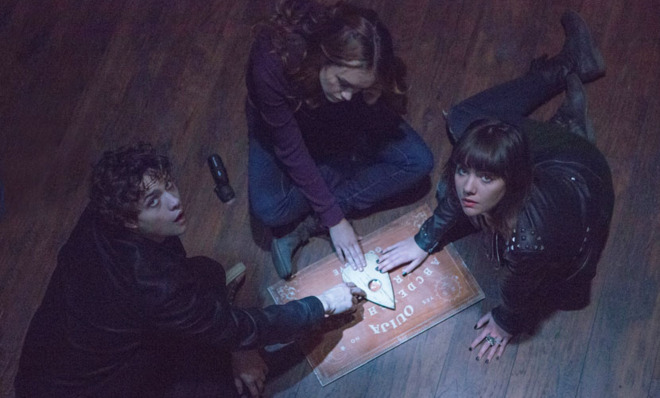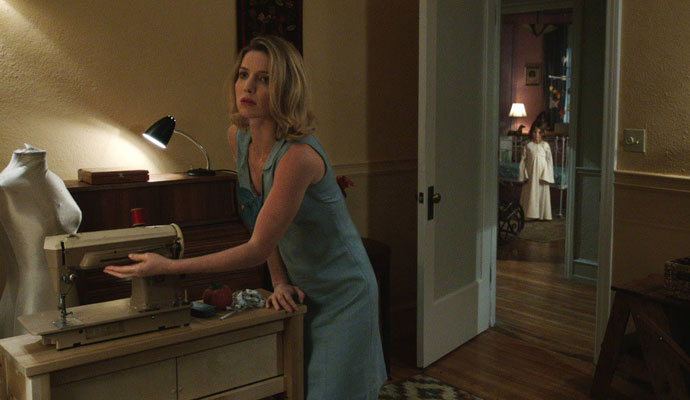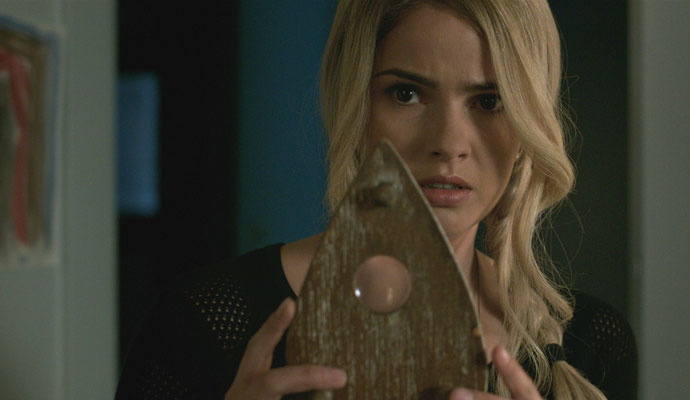6 simple steps for making millions on a crappy horror movie
Want to earn fame and fortune by making the next Ouija? This guide is for you.


Halloween comes a little early this weekend with the release of Ouija, a horror movie based on the Parker Brothers board game of the same name. As one of the only horror movies hitting theaters this October, Ouija's success is virtually assured — but in its original form, it would have been a much bigger gamble. The original version of Ouija was pitched as a pricey blockbuster costing north of $100 million to produce. But Universal — skeptical over the film's box-office chances — drastically retooled the concept, resulting in the $5 million Ouija hitting theaters this weekend.
And here's the thing: they were totally right. At $100 million-plus, Ouija would have needed to be a well-crafted, well-reviewed smash; at $5 million, Ouija cannot fail to be successful. Box-office prognosticators have the film pegged for an opening weekend gross of $24 million to $29 million.
At a time when Hollywood is absolutely desperate for a guaranteed hit, here's a dirty little secret: if you're smart about the way you craft a crappy horror movie, there is basically no way you can lose money on it. How can you get in on some of the sweet, easy profit? Let's look at what's worked before, and make our own crappy horror movie in six easy steps.
The Week
Escape your echo chamber. Get the facts behind the news, plus analysis from multiple perspectives.

Sign up for The Week's Free Newsletters
From our morning news briefing to a weekly Good News Newsletter, get the best of The Week delivered directly to your inbox.
From our morning news briefing to a weekly Good News Newsletter, get the best of The Week delivered directly to your inbox.
1. Choose a premise with some vague, dubious ties to reality
History shows that there's no more reliable premise than "based on a true story" — no matter how thoroughly those "true stories" are debunked. In 2013, The Conjuring grossed a whopping $318 million, after an ad campaign that relied extensively on the real-life people who claimed to have experienced the haunting depicted in the film. This year's Conjuring spin-off Annabelle, which was even cheaper to produce than the original, has grossed $166 million (and counting). This is a strategy Hollywood has employed for decades; since 1979, The Amityville Horror franchise has spawned 11 movies and earned hundreds of millions on the backs of a purported "true story" that has repeatedly been disproven.
Unfortunately, there are only so many real-life people who claim to have met ghosts or monsters or whatever, so for our horror movie, let's follow the Ouija model and go with the next best thing: turning a well-known urban legend into a horror movie. Here's a well-traveled piece of lore that can easily be turned into the basis for a screenplay: A bride, playing hide and seek on her wedding day, climbs into a wooden trunk, accidentally locks herself in, and starves to death. Her body is finally discovered years later, covered in blood from the fingernails she broke as she desperately attempted to claw her way out. That'll make a good first scene.
2. Write a script that will be really cheap to shoot
A free daily email with the biggest news stories of the day – and the best features from TheWeek.com

Here's a fun fact: Every single wide-release horror movie released in 2014 has managed to earn its money back. The vast majority of those movies have grossed way, way more than their budgets: Paranormal Activity: The Marked Ones ($90 million on a $5 million budget), Oculus ($44 million on a $5 million budget), The Purge: Anarchy ($109 million on a $9 million budget), or the aforementioned Annabelle, which cost just $6.5 million to produce.
None of those titles will show up on a list of 2014's highest-grossing films, which will inevitably be dominated by movies like Guardians of the Galaxy, Transformers: Age of Extinction, and the next Hunger Games. But each of those movies cost well over $100 million to produce, and every time you spend that kind of money, you're risking becoming the next Lone Ranger or R.I.P.D.
There is no reason that your crappy Hollywood horror movie should be expensive to produce. (Even the $30 million budget of last summer's Deliver Us From Evil was too high for the profit margin this genre requires.) As a rule, you should aim for a movie that will cost less than $10 million to produce; at those numbers it should basically sell itself.
So what does that mean for our movie? Let's say the Trunk Bride has been dead centuries, which will push the story into the modern day and save us a ton on sets and costumes. The Trunk Bride's ancestor decides to return to the family's long-abandoned ancestral home for his or her own wedding ceremony — unaware that the spirit of the Trunk Bride still haunts the halls, seeking revenge on anyone who attains the happiness she was denied. If any of that ends up costing more than $5 million, let's go back to the script and simplify it.
3. Cast at least one actor with some pull
So we have our story — but who's going to be in it? Fortunately, decades of Hollywood horror movies give us two equally appealing options. Option one: Cast an attractive up-and-comer who will someday be embarrassed they were in this thing. Film history is littered with examples, including a number of Oscar winners: Jennifer Lawrence in The Devil You Know, Jared Leto in Urban Legend, Matthew McConaughey and Renee Zellweger in The Texas Chainsaw Massacre: The Next Generation… get them while they're young, before they have the clout to turn down this kind of work.
Option two: Cast an established talent who is totally fine with slumming it. Ethan Hawke in Sinister, Jessica Chastain in Mama, Daniel Craig in Dream House, Guy Pearce in Don't Be Afraid of the Dark… If you're really lucky, you'll attract somebody like Patrick Wilson, who has successfully launched two separate horror franchises within the past five years: Insidious and The Conjuring. (Fair warning: horror movies with established talents tend to be both more expensive and better-reviewed than horror movies without, so your need for a good producer and a good screenwriter might go up a few notches.)
Back to our movie. It's easy enough to cast the Trunk Bride: find an actress, cover her face in creepy makeup, and put her in a blood-soaked wedding dress. As for the rest of our cast: Let's go with somebody like Texas Chainsaw 3D's Alexandra Daddario (on an upswing from True Detective) as our lead, with Gary Oldman lending an extra dose of credibility in a supporting role as her gruff-but-loving father.
4. Find the right release date

There are three good times to release a horror movie.
Option one: January, when Hollywood studios dump all the duds they don't want to release over the rest of the year (and when audiences, getting tired of all the self-serious Oscar bait, are ready for something a little more mindless). Option two: July, when audiences who have already seen a half-dozen superhero blockbusters are ready for something smaller and scarier. Option three: the first few weeks of October, when audiences spend the month whetting their appetites for Halloween.
All three months have their benefits, but there's another caveat: you don't want to come out too close to another crappy horror movie competing for the same audience. With that in mind, our Trunk Bride movie is probably best off in January 2015, which offers far less competition than July 2015 (the Poltergeist remake) and October 2015 (Frankenstein and The Conjuring 2). Sure, in the real world, a few months isn't nearly enough time to make and market a movie — but then again, how high are we really aiming with this thing?
5. Target teenagers and promote it relentlessly on social media
For decades, Hollywood has relied on extensive cross-platform campaigns to sell its priciest movies: posters, magazine ads, TV spots, interviews with the stars, a steady trickle of ever-more-revealing trailers, a splashy red carpet premiere on both coasts… the list is endless.
And then there's our movie. We don't really want to spend all that money on a dedicated ad campaign — so let's buck the traditional avenues and see how much social media traction we can get out of this thing with our internet-savvy target audience. Let's start with one of those hidden-camera viral videos where we scare unsuspecting passersby — say, a trunk in the middle of the sidewalk with a bloody bride that pops out. Once that buzz is built, it's down to the usual suspects: a website that pretends the whole thing is real, a viral hashtag, and one of those trailers we cut together from the few times people actually jumped or screamed at a test screening. By the time January rolls around, Trunk Bride should basically be self-perpetuating.
6. Watch your money roll in
We did it! Trunk Bride is in theaters, with 19 percent positive reviews and a $26 million opening weekend gross. When it opens abroad, we'll rake in even more. Congratulations! (Now start writing Trunk Bride 2: 'Til Death Do Us Part.)
Scott Meslow is the entertainment editor for TheWeek.com. He has written about film and television at publications including The Atlantic, POLITICO Magazine, and Vulture.
-
 Farage’s £9m windfall: will it smooth his path to power?
Farage’s £9m windfall: will it smooth his path to power?In Depth The record donation has come amidst rumours of collaboration with the Conservatives and allegations of racism in Farage's school days
-
 The issue dividing Israel: ultra-Orthodox draft dodgers
The issue dividing Israel: ultra-Orthodox draft dodgersIn the Spotlight A new bill has solidified the community’s ‘draft evasion’ stance, with this issue becoming the country’s ‘greatest internal security threat’
-
 Sudoku hard: December 13, 2025
Sudoku hard: December 13, 2025The daily hard sudoku puzzle from The Week
